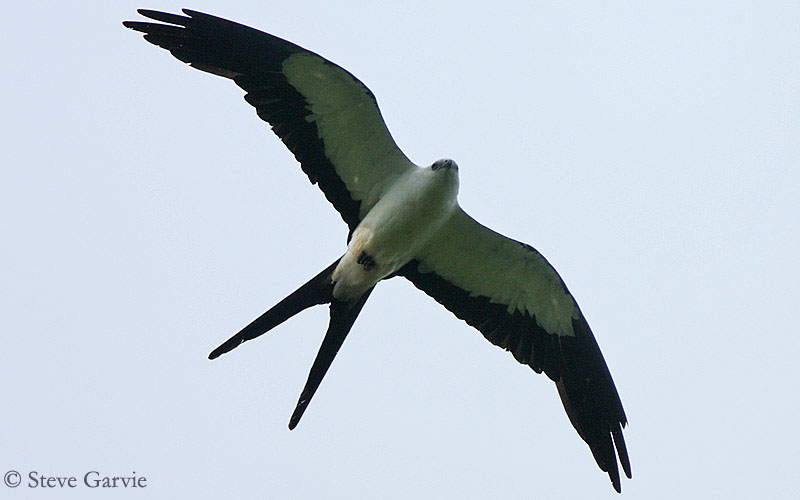
Swallow-tailed Kite
Elanoides forficatus
Accipitriforme Order – Accipitridae Family
BIOMETRICS:
Length: 50-54 cm; Wingspan: 122 cm; Weight: 370-600 g
DESCRIPTION:
Swallow-tailed Kite has contrasting black and white plumage. Tail is long and deeply forked, with black uppertail and white undertail feathers. Back is black, with white broad area on lower back. Wings are thin, long and pointed, with black upperwing and flight feathers, and white underwing coverts.
Underparts, head, nape, neck, breast and belly are white.
Upperparts are slate-grey, with dark violet-grey sheen on scapulars.

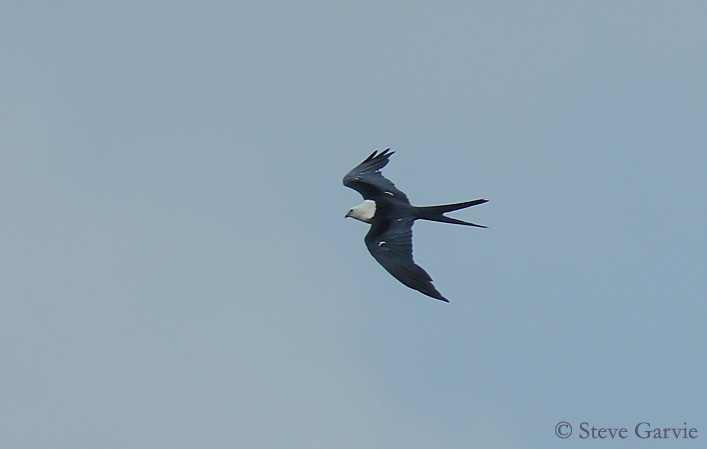
Short and hooked bill is blackish, with black tip and bluish cere. Eyes are reddish-brown to dark brown. Legs and feet are charcoal to pale ashy bluish.
Both sexes are similar.
Juvenile is similar to adults, with shorter tail, and duller plumage.
Immature has some dark streaks on upper breast.
VOICE: SOUNDS BY XENO-CANTO
Swallow-tailed Kite usually utters this triple alarm note “klee-klee-klee” sometimes repeated. We can also hear hissing whistles. It gives these same sharp notes during courtship displays. Female utters higher pitched calls than male.
HABITAT:
Swallow-tailed Kite breeds in lowland swamps or tall riverine woodlands, near prairies and open lands. In Southern Mexico, it may nest at up to 1600 metres in pine forests.
In wintering areas, it lives in humid forests at lower elevation.
RANGE:
Swallow-tailed Kite breeds in extreme South-eastern United States and Florida, but also in Central America and Panama.
It winters in South America.
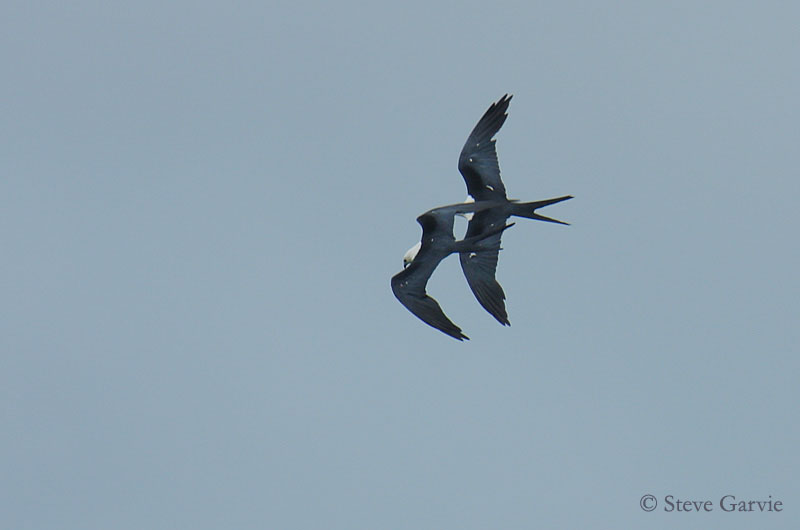
BEHAVIOUR:
Swallow-tailed Kite needs open spaces and prairies to perform its aerial foraging for insects. It catches them in flight with its talons. But it is able to grab small animals from outer leaves and branches, during a continuous flight, or by swooping down from above, or chasing them over the tree tops. It often eats insects while in flight. It drinks by skimming from the surface of water as a swallow. Flocks of up to 15 to 18 birds may forage together when insects are abundant.
When Swallow-tailed Kites arrive on nesting areas, some pairs are yet formed. During breeding season, it performs acrobatics flights. They soar above the area, female often above the male and higher bird swoops down to the other. These flights are often accompanied by vocalizations. Active courtship feeding is also observed.
Copulations begin soon in late February to early March, and confined to the nest-building period, until the start of incubation.
Swallow-tailed Kite protects and defends its nest, threatening and attacking any intruders.
Large numbers of kites gather in communal roosts before migration to South America. The largest contained 1300 to 2200 kites each year at the end of the 20th century, or about 65% of the US population.
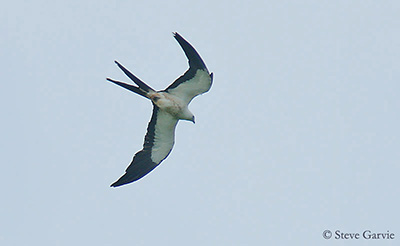
FLIGHT:
Swallow-tailed Kite flies with often spread forked tail, frequently opened and closed to help it in manoeuvring, or rotating it, often almost 90 degrees in order to make a sharp turn. It is very graceful, often seen on the wing, flying over country and performing aerial displays during breeding season. It soars on thermals. Its flight is buoyant, with deep slow wing beats and glides.
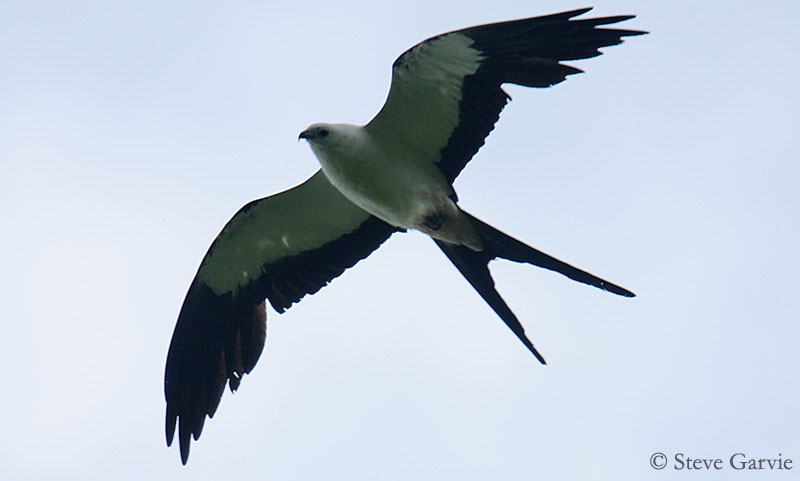
REPRODUCTION:
Swallow-tailed Kite’s nest is built by both parents. They break twigs from exposed branches while are in flight, and they carry them to the nest-site in their talons. The nest is located in pine or cypress trees, near the top of the tallest tree found, at about 60 to 130 feet above the ground. It is a platform of twigs, lined with leaves, lichens and moss, concealed by thick foliage.
From mid-March to mid-April, female lays 1 to 3 creamy white eggs marked with brown. Incubation lasts about 24 to 28 days by both parents, mainly by female while male feeds her at nest. Moss is added during incubation.
During the firs week, female remains with chicks at nest. Male brings food to her, and she feeds the young herself.
Then, both adults bring food at nest. In some case, extra birds may share nesting care and defence of nest and young. They probably are non breeding adults.
Young fledge at about 5 to 7 weeks of age. After fledging, young birds are dependent for food some time more.
This species produces one brood per season.
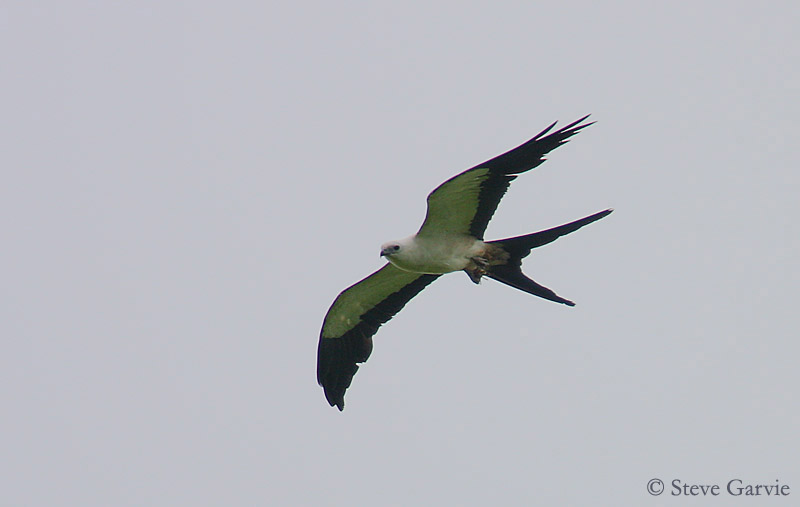
DIET:
Swallow-tailed Kite feeds mainly on insects, but also small birds, eggs and nestlings, reptiles and amphibians.
PROTECTION / THREATS / STATUS:
Swallow-tailed Kite is threatened by habitat loss, and it is vulnerable to pesticides. Their numbers in United States are decreased for persecution, and change in their habitat. It seems that nestling mortality is the result of wind and predation.
Fr: Milan à queue fourchue
All : Schwalbenweih
Esp : Elanio Tijereta
Ital : Nibbio americano codadirondine
Nd : Zwaluwstaartwouw
Sd : Svalstjärtsglada
Photos de Steve Garvie
Son site: RAINBIRDER Photo galleries
Texte de Nicole Bouglouan
Sources :
HANDBOOK OF THE BIRDS OF THE WORLD Vol 2 by Josep del Hoyo-Andrew Elliot-Jordi Sargatal - Lynx Edicions - ISBN: 8487334156
A GUIDE TO THE BIRDS OF MEXICO AND NORTHERN CENTRAL AMERICA by Steve N. G. Howell, Sophie Webb - Oxford University Press - ISBN: 0198540124
A GUIDE TO THE BIRDS OF COLOMBIA by Steven L. Hilty and William L. Brown
Princeton University Press – ISBN 069108372X
All About Birds (Cornell Lab of Ornithology)
The Hawk Conservancy Trust (Hilary Smith)
What Bird-The ultimate Bird Guide (Mitchell Waite)
Animal Diversity Web (University of Michigan Museum of Zoology)